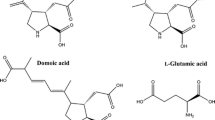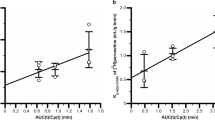Abstract
Among the HMG-CoA reductase inhibitors, lovastatin and simvastatin have central nervous system (CNS) side effects, such as sleep disturbance, whereas pravastatin does not. This difference in CNS side effects may be due to a difference in blood–brain barrier (BBB) permeability among these inhibitors. To test this hypothesis, we compared the BBB transport ability of HMG-CoA reductase inhibitors by using an in vivo brain perfusion technique in rats and an in vitro culture system of bovine brain capillary endothelial cells. The in vivo BBB permeability coefficients of the lipophilic inhibitors, [14C]lovastatin and [14C]simvastatin, were high. In contrast, that of the hydrophilic inhibitor, [14C]pravastatin, was low and not significantly different from that of [14C]sucrose, an extracellular space marker. Similarly, the in vitro BBB permeability coefficients of [14C]lovastatin and [1C]simvastatin were high, while that of [14C]-pravastatin was low. The in vivo and in vitro transcellular permeabilities obtained for HMG-CoA reductase inhibitors were comparable. This study shows that the BBB permeability correlates with the CNS side effects of the HMG-CoA reductase inhibitors.
Similar content being viewed by others
REFERENCES
V. A. Levin. Relationship of octanol/water partition coefficient and molecular weight to rat brain capillary permeability. J. Med. Chem. 23:682–684 (1980).
V. W. Rodwell, J. L. Nordstrom, and J. J. Mitschelen. Regulation of HMG-CoA reductase. Adv. Lipid Res. 14:1–74 (1976).
E. J. Schaefer. HMG-CoA reductase inhibitors for hypercholesterolemia. N. Engl. J. Med. 319:1222 (1988).
J. D. Barth, O. A. E. Kruisbrink, and A. L. V. Dijk. Inhibitors of hydroxymetylglutaryl coenzyme A reductase for treating hypercholesterolemia. Br. Med. J. 301:669 (1990).
R. J. Stubbs, M. S. Schwartz, R. J. Gerson, T. J. Thornton, and W. F. Bayne. Comparison of plasma profiles of lovastatin, simvastatin and pravastatin in the dog. Drug Invest. 2:18–28 (1990).
Y. Takasato, S. I. Rapoport, and Q. R. Smith. An in situ brain perfusion technique to study cerebrovascular transport in the rat. Am. J. Physiol. 247:H484–H493 (1984).
K. L. Audus and R. T. Borchardt. Characterization of an in vitro blood-brain barrier model system for studying drug transport and metabolism. Pharm. Res. 3:81–87 (1986).
T. Terasaki, S. Takakuwa, S. Moritani, and A. Tsuji. Transport of monocarboxylic acids at the blood-brain barrier: Studies with monolayers of primary cultured bovine brain capillary endothelial cells. J. Pharmacol. Exp. Ther. 258:932–937 (1991).
M. Bradbury. The Concept of a Blood-Brain Barrier, John Wiley & Sons, New York, 1979.
S. Meresse, M. P. Dehouck, P. Delorme, M. Bensaid, J. P. Tauber, C. Delbart, J. C. Fruchart, and R. Cecchelli. Bovine brain endothelial cells express tight junctions and monoamine oxidase activity in long-term culture. J. Neurochem. 53:1363–1371 (1989).
J. A. Cooper, P. J. Del Vecchio, F. L. Minnear, K. E. Burhop, W. M. Selig, J. G. N. Garcia, and A. B. Malik. Measurement of albumin permeability across endothelial monolayers in vitro. J. Appl. Physiol. 62:1076–1083 (1987).
O. H. Lowry, N. J. Rosebrough, A. L. Farr, and R. J. Randall. Protein measurement with the Folin phenol reagent. J. Biol. Chem. 193:265–275 (1951).
J. R. Cove-Smith and C. A. Kirk. CNS-related side-effects with metoprolol and atenolol. Eur. J. Clin. Pharmacol. 28:69–72 (1985).
E.-CH., Foerster, P. Greminger, W. Siegenthaler, H. Vetter, and W. Vetter. Atenolol versus pindolol: Side-effects in hypertension. Eur. J. Clin. Pharmacol. 28:89–91 (1985).
W. M. Pardridge, D. Triguero, J. Yang, and P. A. Cancilla. Comparison of in vitro and in vivo models of drug transcytosis through the blood-brain barrier. J. Pharmacol. Exp. Ther. 253:884–891 (1990).
A. T. M. Serajuddin, S. A. Ranadive, and E. M. Mahoney. Relative lipophilicities, solubilities, and structure-pharmacological considerations of 3-hydroxy-3-methylglutaryl-coenzyme A (HMG-CoA) reductase inhibitors pravastatin, lovastatin, mevastatin, and simvastatin. J. Pharm. Sci. 80:830–834 (1991).
Author information
Authors and Affiliations
Rights and permissions
About this article
Cite this article
Saheki, A., Terasaki, T., Tamai, I. et al. In Vivo and in Vitro Blood–Brain Barrier Transport of 3-Hydroxy-3-Methylglutaryl Coenzyme A (HMG-CoA) Reductase Inhibitors. Pharm Res 11, 305–311 (1994). https://doi.org/10.1023/A:1018975928974
Issue Date:
DOI: https://doi.org/10.1023/A:1018975928974




